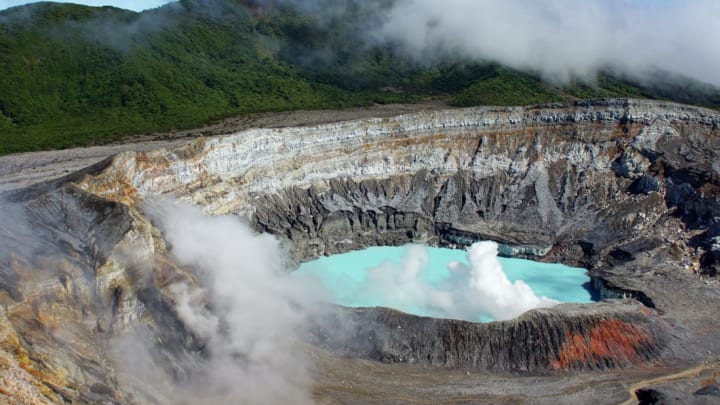These 10 lakes, pools, and beaches should be approached with caution—or not approached at all.
1. Laguna Caliente
Volcanoes do crazy things to water. With a pH as low as "slightly below zero," Laguna Caliente (situated in the summit crater of Poás Volcano) is probably the most acidic body of water on the planet. The rain that falls around the area has a pH of 2.0 on average.
2. Nyriragongo Crater's lava lake
Two hundred and eighty-two million cubic feet of molten rock won't make for a pleasant game of Marco Polo, but you can probably roast a marshmallow from several hundred yards. The world's largest permanent lava lake rests in one of the eight volcanoes of the Virunga range of Africa. Last year, a team of scientists and explorers survived a journey to the rim of the lake, which is detailed here in a stunning photo essay.
3. Just about any body of water in China
Heavy traffic (both on roads and waterways), industrial pollution, and uncontrolled fertilizer use have contributed to a national water crisis in China. Nearly every major lake and river in the country is currently experiencing toxic green-blue algae bloom. Greenpeace tested waters in 25 regions and found 20 of the samples too high in nitrogen and nitrates to be safe for human use. In fact, the concentrations were so high that the water can't even be used for watering plants or industrial purposes.
4. Lake Karachay
In Soviet Russia, lake contaminate you. From 1951 until 1968, this small lake in the Ural Mountains was used as a toxic dump site for Mayak, a nuclear waste storage and processing facility. Between 1978 and 1986, the lake was filled with concrete blocks to prevent the shifting of irradiated sediment. In 1990, the radiation level measured more than high enough to deliver a lethal dose to a human within an hour.
5. Any exploding lake
There are only three known exploding lakes in the world: Lake Kivu in Rwanda and Lakes Monoun and Nyos in Cameroon. Created by a dam of volcanic rock, this type of lake lies atop a pool of magma that releases carbon dioxide and methane into the water. On occasion, a large pocket of toxic gas will "explode" from the water (a limnic eruption); this happened in 1984 at Lake Monoun, killing 37 people, and again in 1986 at Lake Nyos, suffocating 1700 people and 3500 livestock.
6. Berkeley Pit
Formerly an open-pit copper mine, the Berkeley Pit in Butte, Montana, is filled with acidic, highly oxygenated water that leaches heavy metals from the surrounding rock. The Superfund list of contaminants is arsenic, cadmium, copper, zinc, and lead. In 1995, a flock of 342 geese was found dead in the Pit with burns from the water in their internal organs.
7. Lake Vostok
Lake Vostok is an oligotropic subglacial lake under the Antarctic. Information collected from ice cores will reveal whether life has survived in isolation for 15 to 24 million years and the probability of life in subsurface water on other planets. Even if scientists discover ice-loving fish below, you can't swim there—the average water temperature is calculated to be -3ºC.
8. Boiling Lake in Dominica
Featured in the Angry Planet episode, "Across the Boiling Lake," the flooded fumarole's shore temperature is between 185 and 197ºF, but the central area of the lake hasn't been measured because no one can get there safely. It can be clearly observed that the water is actively boiling, however, so showing off your sweet cannonball skills is probably a bad idea.
9. The Amazon Basin
Even Hank Hill's narrow urethra wouldn't save him from the candiru (or toothpick fish) native to Amazonian waters. Though formal experimentation shows the fish is not attracted to urine (as previously believed), it is in fact small enough to, uh, invade a person. One such incident was documented in 1997; the "River Monsters" episode of Animal Planet investigated the claim, which was fully verified.
10. The Northern and Eastern beaches of Australia
Remember the scene in Finding Nemo when Marlin and Dory are in the jellyfish field? That's a slightly exaggerated idea of what the coastal waters of Australia are like, except these are lethal box jellyfish (and blue-ringed octopus, cone shells, scorpion fish, crocodiles, and sting rays) and you're not an animated fish.
